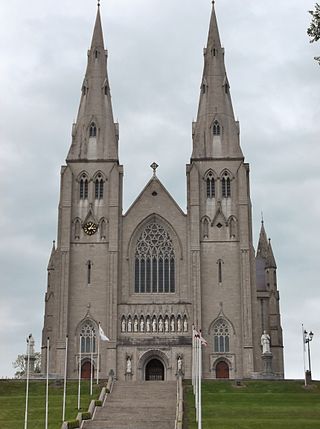
An organ stop is a component of a pipe organ that admits pressurized air to a set of organ pipes. Its name comes from the fact that stops can be used selectively by the organist; each can be "on", or "off".

The Metropolitan Cathedral Church of Saint Andrew or Glasgow Metropolitan Cathedral is a Roman Catholic Cathedral in the city centre of Glasgow, Scotland. It is the mother church of the Roman Catholic Archdiocese of Glasgow. The cathedral, which was designed in 1814 by James Gillespie Graham in the Neo Gothic style, lies on the north bank of the River Clyde in Clyde Street. St Andrew's Cathedral is the seat of the Archbishop of Glasgow, currently William Nolan. It is dedicated to the patron saint of Scotland, Saint Andrew.

The Cathedral of Christ the Light, also called Oakland Cathedral, is the cathedral of the Roman Catholic Diocese of Oakland in Oakland, California. It is the seat of the Bishop of Oakland. Christ the Light, the first cathedral built entirely in the 21st century, replaced the Cathedral of Saint Francis de Sales, irreparably damaged in the Loma Prieta earthquake of 1989.

St. Patrick's Cathedral in Armagh, Northern Ireland is the seat of the Catholic Archbishop of Armagh, Primate of All Ireland. It was built in various phases between 1840 and 1904 to serve as the Roman Catholic Cathedral of the Archdiocese of Armagh, the original Medieval Cathedral of St. Patrick having been appropriated by the state church called the Church of Ireland at the time of the Irish Reformation.

Chelmsford Cathedral in the city of Chelmsford, Essex, England, is dedicated to St Mary the Virgin, St Peter and St Cedd. It became a cathedral when the Anglican Diocese of Chelmsford was created in 1914 and is the seat of the Bishop of Chelmsford.

Doncaster Minster, formally the Minster and Parish Church of St George, is the Anglican minster church of Doncaster, South Yorkshire, England. It is a grade I listed building and was designed by architect designer George Gilbert Scott. The church was built in 1854–1858 to replace an earlier building destroyed by fire. It is an active place of worship and has a Schulze organ, a ring of eight bells, and a celebrated clock by Dent. The church is one of two parish churches to have minster status in South Yorkshire. The other is the minster church of Rotherham.

St Martin in the Bull Ring is a Church of England parish church in the city of Birmingham, West Midlands, England. It is the original parish church of Birmingham and stands between the Bull Ring Shopping Centre and the markets.
Sir William Romney's School is an 11–16 secondary school with academy status in Tetbury, Gloucestershire, England. Pupils come from the Tetbury, Leighterton, Stroud, Cirencester, Nailsworth and Avening areas. In 2016 the school achieved a 'Good' rating from Ofsted.

The Parish of Taney is a populous parish in the Church of Ireland, located in the Dundrum area of Dublin.

St Paul's is a Church of England church in the Georgian St Paul's Square in the Jewellery Quarter, Birmingham, England.

St Peter and St Paul is a church in the town of Bromley, Borough of Bromley, in south east London. Known familiarly as Bromley Parish Church, it is not far from Bromley High Street and approximately halfway between Bromley North and Bromley South railway stations. The church is part of the Diocese of Rochester within the Church of England. Largely destroyed by bombing during the Second World War, St Peter and St Paul was rebuilt in the 1950s. It has been Grade II* listed since 1955.

St Anne's Church is in Church Road, Singleton, Lancashire, England. It is an active Anglican parish church in the deanery of Poulton, the archdeaconry of Lancaster, and the Diocese of Blackburn. Its benefice is united with those of St Chad, Poulton, and St Hilda, Carleton. It is recorded in the National Heritage List for England as a designated Grade II listed building.

The Church of Saint Colman is a Roman Catholic parish church in the parish of Claremorris and Barnacarroll, in Ireland. It designed in Early English Gothic style by R. M. Butler, and it was built in 1911. It is located in the centre of Claremorris, County Mayo, Ireland.

All Saints' Church, Lincoln is a parish church on Monks Road in Lincoln in the Church of England.

All Saints Church, Cheltenham, is a Grade I listed parish church in the Church of England in Cheltenham.
The Brindley organ of St Mary's Church, Tickhill, South Yorkshire, England is a Victorian pipe organ influenced by the German organ building tradition.

St Mary's Church is the Church of England parish church of Haddenham, Buckinghamshire It is a Grade I listed building.

Casavant Frères Ltée. Opus 1841 is a pipe organ built by the famous Casavant Frères of Saint-Hyacinthe, Quebec. The organ was first completed in 1911 as Casavant Brothers - Opus 452 for St. Andrew's Presbyterian Church at 40 Bentinck Street, Sydney, Nova Scotia, Canada. St. Andrew's later became St. Andrew's United Church and is now the Highland Arts Theatre.

St Martin and St Meriadoc's Church, Camborne is a Grade I listed parish church in the Church of England in Camborne, Cornwall.




















